Is forced ventilation necessary in the bathroom: standards and stages for arranging effective air exchange
Musty air in the bathroom and fungus on the walls are all consequences of insufficient air exchange. Breathing stale air or simply taking a shower in such a room is not only unpleasant, but also harmful to health. Do you agree? But it is possible to avoid these negative phenomena if you equip an effective air exchange system.
And we will discuss in detail how to do this in our article - we will find out whether forced ventilation is needed in the bathroom or whether it will be enough to use natural ventilation. Let's look at the regulatory requirements and features of the ventilation system.
The content of the article:
Bathroom ventilation requirements
What an effective, practical and reliable air exchange system should be like is stated in a number of domestic by-laws:
- GOST 30494-2011, where it is described what the microclimate in the premises should be;
- SP 60.13330.2012, which sets out the requirements and rules indicating what ventilation should be.
In addition, air exchange is discussed in SP 55.13330.2016 And SP 54.13330.2016, but they refer to the Code of Practice indicated above.
The listed by-laws state that air exchange is necessary to maintain air quality at the required level.
It will be such if the content of harmful substances does not exceed moderate values. For example, when the amount of carbon dioxide in each cubic meter is no more than 400 cm³.400-600 cm³ is considered average, 600-1000 cm³ is not comfortable, but acceptable, and above 1000 cm³ is very low air quality.
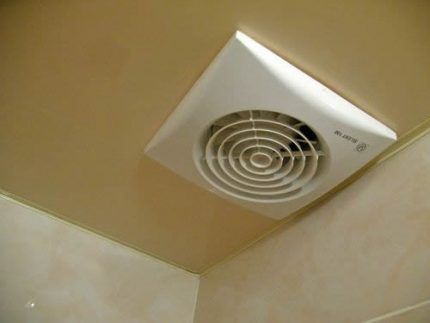
At the same time, when organizing air exchange in residential and office premises, including the bathroom, it should be remembered that it should help create comfortable living conditions.
To do this, the following must be supported at the required level:
- air temperature;
- indoor air speed;
- air humidity;
- the resulting temperature and its local asymmetry.
All these indicators comprehensively characterize the impact on humans of the above indicators, as well as thermal radiation. That is, the temperature in the bathroom should be 24-26 °C, which is the optimal value. And it is guaranteed not to fall below 18 °C, since the specified value is considered the minimum acceptable. In this case, the resulting temperature should be in the range of 23-27 °C, and the allowed values of its asymmetry are between 17 °C and 26 °C.

The relative humidity in bathrooms is not regulated, but usually hoods are installed there, designed to remove air from the entire private house or apartment outside the building. What affects the characteristics of residential premises.Therefore, it is necessary to take into account that the humidity in rooms where people are located should be within 30-45% (in summer), and in winter it can reach 60%.
In any of these cases, the air movement speed (optimal) should not exceed 0.15 m/s. The acceptable value of this parameter is 0.2 m/s.
In this case, significant differences in the above values are unacceptable. For example, living conditions can be considered optimal if the temperature fluctuates within 2 °C, and acceptable if there are sudden changes that do not exceed 3 °C.
Temperature characteristics should also be similar throughout the entire height of the room. So, if the differences exceed 2 °C, then living conditions cannot be called optimal.

And maintaining all the above characteristics without organizing an effective air exchange system is an impossible procedure.
When is forced ventilation needed?
The relevant guidance documents say that air exchange in residential and any other premises can be carried out in various ways. Namely, using natural, forced or mixed ventilation.
And what type of air exchange to choose depends on the conditions of a particular room. So, whether a fan is needed or not in a particular bathroom depends on the performance and stability of natural ventilation.More precisely, whether it can provide sufficient air exchange to maintain optimal or at least acceptable conditions.

Proper ventilation should remove at least 25 m³ of air from the bathroom every hour, and at least 90 m³ of air from living rooms and the bathroom. This indicator is relevant if there is an exhaust hood in the bathroom, which provides ventilation to the rooms in which residents regularly sit and relax.
Moreover, the indicated values are considered the minimum possible and in reality, air exchange should often be more efficient and productive. The reason for this is the insufficient quality of the supplied street air. For example, due to the significant amount of carbon dioxide, the amount of which in large cities can easily reach 400 cm³, and in small cities - 375 cm³ for every cubic meter of air.
As a result, in order to reduce CO2 To achieve optimal values, a much larger amount of outside air may often be needed. For example, to maintain optimal conditions in the bathroom, you may need not the minimum 25 m³ of air per hour, but up to 150 m³.
But the biggest difficulty is that the natural ventilation system is not stable. And if the air outside the window warms up to 15 ° C, then with the windows closed its effect will become almost zero.

In addition, it is quite difficult to determine the effectiveness of natural ventilation - for this you will have to take measurements indoors, and at a time when the outside air temperature is 5 ° C. In addition, this requires special equipment. Therefore, in most cases, indicators that it is time to get a fan are: fungus or mold in the bathroom (for example, in the seams between tiles, other secluded places) or an unpleasant odor. After all, most negative processes occur without visible signs and become apparent only in advanced stages.
Another important disadvantage of natural air exchange is the inability to effectively regulate its performance.
In addition, the use of energy-efficient windows and doors significantly affects the performance characteristics of the traditional system. The tightness of which is disrupted by natural air exchange processes.
As a result, we can point out that natural ventilation is structurally reliable, inexpensive and capable of coping with the functions assigned to it. But with the exception of critical moments caused by instability of natural air exchange and significant loads when using the bathroom.
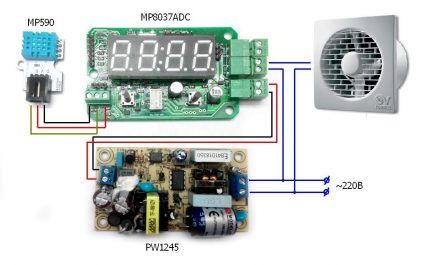
Taking all these points into account, the optimal alternative solution is the use of a mixed ventilation system.It will remove contaminated air and moisture on an ongoing basis naturally, and under significant loads - forcibly, that is, with the help of a fan.
Which is more likely to make living conditions comfortable and non-hazardous to health, and at moderate costs.
At the same time, you should not use a fan on a regular basis. Since this significantly increases operating costs and reduces fire safety.
The procedure for arranging an air exchange system
Creating ventilation in the bathroom is a responsible procedure. After all, it is necessary to ensure effective air exchange with minimal heat loss. In addition, the system must be safe, especially when a fan will be used. Since it is electric, and in the bathroom there is traditionally high humidity and splashes are present during hygiene procedures.
To take into account all of the above and other points, the creation of any ventilation system should begin with drawing up technical specifications.
Then they move on to the practical part, which consists of 3 stages:
- design;
- installation;
- performance check.
Let's consider each of the stages of ventilation arrangement in more detail.
Stage #1 - drafting
A stage such as design should not be ignored even when creating a ventilation system in an apartment. Moreover, even in one where all the necessary channels and many other structural elements are already provided. Since it is at this stage that it is decided whether the system will be safe and effective.
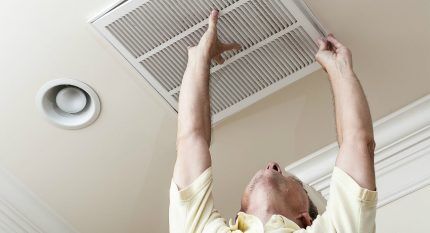
In addition, it is the design that will make it possible to create a ventilation system:
- structurally simple, which will ensure reliability and durability;
- easy to maintain, which will make it possible for residents to carry out all the necessary work themselves, and this will reduce operating costs;
- repairable, which will allow you to quickly and without significant costs replace a faulty unit or element of the system.
And also the design will eliminate the reduction in the aesthetic qualities of the interior of the room.
In this case, it is advisable to use the fan in conjunction with a humidity sensor. Since the presence of this device will effectively influence the air quality and microclimate in general. Moreover, without the participation of residents and excessive consumption of electricity. We discussed in detail how to connect a fan with a humidity sensor. In this article.

In addition, to set up an effective air exchange system, it is not enough to know why a modern fan is needed in the bathroom; you also need to have special knowledge that will help you make the right one choosing a suitable fan.
For example, the noise level of the device should not exceed 35 dB, since ignoring this standard can have a negative impact on health. In this case, the electric motor must be protected from splashes. To choose a silent fan, we recommend that you read rating of the best models.
Stage #2 - installation and connection of the fan
Installation of modern ventilation equipment is a procedure no less important than design. The reason is that creating a project in reality is quite difficult, especially for people who do not have a sufficient supply of skills, experience and equipment. But it depends on the quality of work and punctuality of the performers whether the characteristics of the ventilation system will comply with the provisions of the project.
Cracks, holes, and other changes in the design that arose during poor-quality installation can reduce the effectiveness of the ventilation system. And also, air exchange is often affected by the incorrect selection of components. For example, when a fan is installed in the system, this will lead to the need to install ventilation valves in metal-plastic windows or walls, which will ensure the flow of outside air in optimal quantities.
If at the same time a decision is made to simplify the system or inattention is shown when choosing a fan and devices to ensure air flow, then you should expect trouble. For example, in the form of backdraft and associated costs to eliminate it.
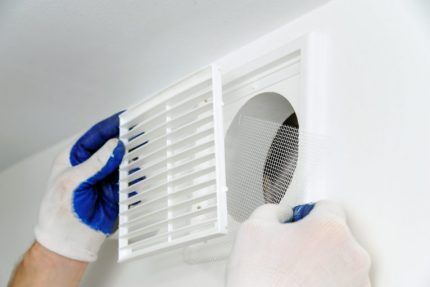
Therefore, it is advisable to entrust all work on modernizing the ventilation system in the bathroom exclusively to specialists and enter into appropriate agreements with them. This is necessary to avoid liability for work done incorrectly, for example, unsuccessfully drilled boxes, damaged structures, etc.
To perform the installation itself, a number of operations must be performed:
- Dismantling the old ventilation grilleinstalled on the vent;
- Determining places for drilling holes for screws that secure the fan;
- Drilling holes, which is done using a hammer drill or impact drill;
- The fan is fastened using screws included in the delivery of the unit.
If you don’t have power tools, you can install the fan using liquid nails or high-quality silicone glue. But to do this, it is necessary to clear the seat of plaster and other materials that will reduce the quality of the work.
The last stage of installation of this product is the installation of electrical wires to connect to the power supply, which must be hidden in the wall. If this rule is ignored, the operation of the fan will not be safe enough. And the aesthetic properties of the room are low.
Since connecting the fan to the electrical network is a labor-intensive and costly procedure, it is advisable to carry it out simultaneously with renovations in the bathroom.
If you prefer to install and connect a fan in the bathroom yourself, we recommend that you familiarize yourself with the popular diagrams and tips for installation.
Stage #3 - checking system functionality
A performance check should not be ignored under any circumstances, because it will help to detect problems in a timely manner and prevent the onset of negative consequences.
The reason is that it allows you to promptly identify:
- errors and inaccuracies;
- reduced safety of living if there is a gas water heater in the bathroom.
Moreover, the most important procedure is monitoring the performance of the ventilation system as a whole.
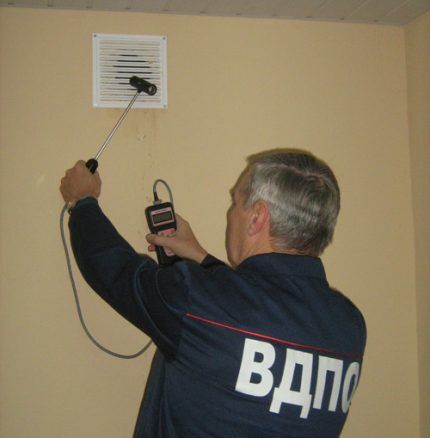
Checking the ventilation system should not be done using the attached piece of paper or a lit match, but using special equipment that makes it possible to determine the effectiveness of the system.
Such diagnostics are especially important when installing a fan and other mechanical devices that significantly affect changes in air exchange. Therefore, specialists should be involved in checking the functionality.
We talked about the rules for checking the operation of ventilation ducts in our other article.
Conclusions and useful video on the topic
The video below explains how to create a ventilation system:
Air exchange in the bathroom must be efficient. And this can be achieved if you use a reliable and inexpensive natural ventilation system with a fan installed in its duct. Which will increase the efficiency and stability of ventilation at critical moments. Since most of the time there is no need for forced air exchange.
Would you like to tell us about your experience in installing a ventilation system in your bathroom? Or would you like to supplement the above material with useful information? Ask questions, share your experience, participate in discussions - the feedback form is located below the article.



